Indonesian Scientists’ Behavior Relative to Research Data Governance in Preventing WMD-Applicable Technology Transfer
Abstract
1. Introduction
1.1. Research Questions
1.2. Literature Review
2. Theoretical Model and Hypotheses
2.1. Planned Behavior and Protection Motivation Theories
2.2. Research Model and Hypothesis
3. Materials and Methods
3.1. Data Collection
3.2. Research Instruments
3.3. Analysis Methods
4. Results
5. Discussions
5.1. Research Implications
5.2. Practice Implications
5.3. Limitations and Future Works
Author Contributions
Funding
Institutional Review Board Statement
Informed Consent Statement
Data Availability Statement
Acknowledgments
Conflicts of Interest
Appendix A
Appendix A.1
| No | Question |
|---|---|
| 1 | Age |
| 2 | Gender |
| 3 | Last education |
| 4 | Research experience |
| 5 | Main affiliation |
| 6 | If main affiliation is a university, accreditation of the affiliated university; if you are unsure about choosing one of the options, please refer to https://pddikti.kemdikbud.go.id (accessed on 1 March 2022) |
| 7 | Scientific field; if you have doubts about choosing one of the options, please refer to: https://service.elsevier.com/app/answers/detail/a_id/15181/supporthub/scopus (accessed on 1 March 2022) |
Appendix A.2
- Scientific experiment;
- Models and simulations, e.g., models with associated metadata and computational data arising from the models;
- Observation, namely, a particular phenomenon at a specific time or location;
- Interviews;
- Survey.
- Notes, graphs, tables, maps, images, videos, audio, or visual recordings;
- Voice recordings and transcripts of interview activities;
- Derived data, namely, data that results from processing and combining raw data;
- Canonical or reference data, e.g., gene sequences, chemical structures, and others;
- Materials that accompany research activities, including coding instructions, interview instructions, flow charts of data collection, questionnaires, information on research methods and techniques used, code books, data collection instruments, statistical summaries, database dictionaries, summary/description of activities, and bibliographies of publications related to the data;
- Scientific articles or technical/research reports that are the outputs of research activities.
| No | Question | Control form |
|---|---|---|
| 1 | Do you have access to any of the materials listed above? “Access” entails the potential to view data. It does not necessarily entail working with the data. | If “No” was chosen, jump to question no. 17. |
| 2 | By what means is this material collected? | |
| 3 | Do you work on the material, and with whom? | If there was no answer, jump to question no. 6. |
| 4 | Where do you process the material? | |
| 5 | Where do you store the materials (either the raw materials or the results of the material processing)? | |
| 6 | In your opinion, how often can the material you are working with be shared by other parties? | |
| 7 | Have you ever shared or sent the material to other parties? | If “Never” was chosen, jump to question no. 11. |
| 8 | With whom did you share the material? | |
| 9 | What media did you use to share the material? | |
| 10 | In your opinion, how often do you feel that the means (media) you have used to share the materials was adequately safe, given the nature of the material? “Safe” in this context means that only the intended receivers can have intended access to the materials. | |
| 11 | How often have you sent material and subsequently informed the receivers not to share the material with third parties? | |
| 12 | When retrieving material from a repository, do you read the terms and conditions? | |
| 13 | When storing material to a repository, do you read the terms and conditions? | |
| 14 | In your opinion, how often do you feel that the means by which you store the material is adequately safe, relative to the nature of the material? By “safe”, we mean that no unintended parties have unintended access to the materials. | |
| 15 | In your opinion, how likely is it that unauthorized parties could have access and make improper use some or all of the material you currently have? | |
| 16 | Have you ever locked a document or folder? “Lock” in this context means a mechanism that restricts access and sets access rights. | |
| 17 | What is your level of knowledge of research data governance best practices? | |
| 18 | To your knowledge, does your institution have policies and procedures related to research data governance? | If “No” or “Do not know” was chosen, jump to Part 3. |
| 19 | What is your level of knowledge of your institution’s policies or procedures regarding research data governance (data deposition, disclosure, access, use, and data preservation)? |
| Variable | Code | Description of Indicator | Adopted From |
|---|---|---|---|
| WMD and Data Governance Awareness | aw1 | I am aware that there is a potential threat of misuse of research data being used as a WMD. | [59] |
| aw2 | I have sufficient knowledge about the consequences of misuse of research data as a WMD. | ||
| aw3 | I understand the risk of incidents of access to research data by WMD those who could use it as a WMD. | ||
| aw4 | I continue to update myself regarding data governance awareness in preventing misuse of research data from being applied to become WMD by irresponsible parties. | ||
| aw5 | I share knowledge of data governance with my colleagues in preventing misuse of research data from being used as a WMD to raise my awareness. | ||
| Data Governance Organization Policy | op1 | Research data governance policies and procedures are central to my organization. | [59] |
| op2 | Research data governance policies and procedures influence my behavior. | ||
| op3 | Research data governance policies and procedures caught my attention. | ||
| op4 | Behavior that conforms to research data policies and governance is a value in my organization. | ||
| op5 | I have sufficient knowledge about government policies related to data governance. | ||
| Data Governance Experience and Involvement | ei1 | Experience in research data governance enhances my ability to behave safely. | [59] |
| ei2 | I am actively involved in the governance of research data, and I care about my behavior in my work. | ||
| ei3 | Experience helps me identify and assess threats from unwanted parties accessing protected research data. | ||
| ei4 | I can sense the threat of research data misuse because of my experience. | ||
| ei5 | Experience helps me to do research data governance. | ||
| ei6 | I have the appropriate ability to manage risks related to research data security due to my experience. | ||
| Attitude | att1 | Data governance is needed to prevent and reduce the risk of misuse of research data as a WMD. | [53,55,59] |
| att2 | Data governance helps provide a sense of security for research results to prevent misuse of research data as a WMD. | ||
| att3 | Practicing data governance is a good idea to prevent misuse of research data from being used as a WMD. | ||
| att4 | I have a positive view of changing the behavior of my colleagues to conduct research data governance. | ||
| att5 | I believe that research data governance is very valuable in an organization. | ||
| Subjective Norm | sn1 | Research data governance policies and procedures in my organization are important to my colleagues. | [53,55,59] |
| sn2 | Research data governance policies and procedures in my organization influence my behavior. | ||
| sn3 | The research data governance culture in my organization influences my behavior. | ||
| sn4 | My supervisor’s research data governance influences my behavior. | ||
| sn5 | To date, I have carried out research data governance following the practice carried out by my seniors. | ||
| sn6 | The management of research data that I do cannot be separated from the direction of my superiors. | ||
| Perceived Behavioral Control | pbc1 | I believe that research data governance is not a difficult thing. | [55,59] |
| pbc2 | I believe that experience helps me be careful in conducting research data governance. | ||
| pbc3 | Following research data governance policies and procedures is easy for me. | ||
| pbc4 | Research data governance is a doable practice. | ||
| Threat Appraisal | ta1 | It is a serious problem if other parties can access my research data without my consent or knowledge. | [51,53,54] |
| ta2 | Misuse of research data is a serious problem. | ||
| ta3 | I know the possibility of misuse of research data increases if I do not consider data governance policies and procedures. | ||
| ta4 | I can become a victim of an attack if I do not follow research data governance policies and procedures. | ||
| ta5 | My research data security will be weak if I do not consider data governance policies and procedures. | ||
| ta6 | I do not share harmful research data with the public to reduce risk. | ||
| Coping Appraisal | ca1 | Currently, the steps I take to prevent unwanted parties from accessing my research data are sufficient. | [51,53,54] |
| ca2 | Currently, the steps I take to prevent misuse of research data are sufficient. | ||
| ca3 | I have the necessary skills to protect my research data. | ||
| ca4 | I have the expertise to secure my research data from being accessed by unwanted parties. | ||
| ca5 | I believe that the protection of my research data is within my control. | ||
| ca6 | I have the ability to prevent the misuse of my research data. | ||
| Data Governance Behavior | dgb1 | I follow data governance policies and procedures to protect research data and prevent misuse of that data. | [55,59] |
| dgb2 | I consider expert recommendations in conducting research data governance. | ||
| dgb3 | Before taking any action regarding research data governance, I think about the consequences first. | ||
| dgb4 | I consider my previous experience in research data governance to avoid repeating previous mistakes. | ||
| dgb5 | I am always trying to change my habits of practicing research data governance. | ||
| dgb6 | After getting the research data, I have planned from the beginning how the data will be managed, stored, and processed. |
| 1 | https://data.go.id (accessed on 21 September 2022). |
| 2 | https://data.brin.go.id (accessed on 21 September 2022). |
| 3 | https://peraturan.bpk.go.id/Home/Details/108813/perpres-no-39-tahun-2019 (accessed on 21 September 2022). |
| 4 | https://perpus.menpan.go.id/opac/detail-opac?id=2447 (accessed on 21 September 2022). |
| 5 | https://jdih.kemenkeu.go.id/in/dokumen/peraturan/cd275d59-a40d-4b48-f105-08d8ac6015bf (accessed on 21 September 2022). |
| 6 | https://jdih.brin.go.id/peraturan/view/3b3e5791-f61a-4884-b809-94f1d242ef47 (accessed on 21 September 2022). |
| 7 | https://survei.risnov.id (accessed on 21 September 2022). |
| 8 | https://sinta.kemdikbud.go.id/ (accessed on 21 September 2022). |
| 9 | https://service.elsevier.com/app/answers/detail/a_id/12007/supporthub/scopus (accessed on 21 September 2022). |
References
- Janssen, M.; Brous, P.; Estevez, E.; Barbosa, L.S.; Janowski, T. Data governance: Organizing data for trustworthy Artificial Intelligence. Gov. Inf. Q. 2020, 37, 101493. [Google Scholar] [CrossRef]
- Micheli, M.; Ponti, M.; Craglia, M.; Berti Suman, A. Emerging models of data governance in the age of datafication. Big Data Soc. 2020, 7, 205395172094808. [Google Scholar] [CrossRef]
- Winter, J.S.; Davidson, E. Big data governance of personal health information and challenges to contextual integrity. Inf. Soc. 2019, 35, 36–51. [Google Scholar] [CrossRef]
- Abraham, R.; Schneider, J.; vom Brocke, J. Data governance: A conceptual framework, structured review, and research agenda. Int. J. Inf. Manag. 2019, 49, 424–438. [Google Scholar] [CrossRef]
- Khatri, V. Managerial work in the realm of the digital universe: The role of the data triad. Bus. Horizons 2016, 59, 673–688. [Google Scholar] [CrossRef]
- Putera, P.B.; Manik, L.P.; Rianto, Y.; Sari, A.A.; Sadikin, R. How Indonesia Uses Big Data “Indonesian One Data” for the Future of Policy Making. Int. J. Adv. Sci. Technol. 2020, 29, 2177–2185. [Google Scholar]
- Anggawira, D.; Mayesti, N. The Indonesian National Scientific Repository: A Case Study of Research Data Sharing. Preserv. Digit. Technol. Cult. 2020, 49, 14–25. [Google Scholar] [CrossRef]
- Hardy, K.; Maurushat, A. Opening up government data for Big Data analysis and public benefit. Comput. Law Secur. Rev. 2017, 33, 30–37. [Google Scholar] [CrossRef]
- Wenzel, R.; Quaquebeke, N.V. The Double-Edged Sword of Big Data in Organizational and Management Research: A Review of Opportunities and Risks. Organ. Res. Methods 2018, 21, 548–591. [Google Scholar] [CrossRef]
- Forge, J. A Note on the Definition of “Dual Use”. Sci. Eng. Ethics 2010, 16, 111–118. [Google Scholar] [CrossRef]
- Fraser, C.M.; Dando, M.R. Genomics and future biological weapons: The need for preventive action by the biomedical community. Nat. Genet. 2001, 29, 253–256. [Google Scholar] [CrossRef] [PubMed]
- Borgman, C.L. The conundrum of sharing research data. J. Am. Soc. Inf. Sci. Technol. 2012, 63, 1059–1078. [Google Scholar] [CrossRef]
- Solomonides, A. Research Data Governance, Roles, and Infrastructure. In Clinical Research Informatics; Richesson, R.L., Andrews, J.E., Eds.; Springer International Publishing: Cham, Switzerland, 2019; pp. 291–310. [Google Scholar] [CrossRef]
- Kouper, I.; Raymond, A.H.; Giroux, S. An Exploratory Study of Research Data Governance in the U.S. Open Inf. Sci. 2020, 4, 122–142. [Google Scholar] [CrossRef]
- Borgman, C.L. Research Data: Who will share what, with whom, when, and why? In Proceedings of the Fifth China—North America Library Conference, Beijing, China, 8–12 September 2010; p. 21. [Google Scholar]
- Mlangeni, T.C.; Ruhode, E. Data Governance: A Challenge for Merged and Collaborating Institutions in Developing Countries. In Information and Communication Technologies for Development; Series Title: IFIP Advances in Information and Communication, Technology; Choudrie, J., Islam, M.S., Wahid, F., Bass, J.M., Priyatma, J.E., Eds.; Springer International Publishing: Cham, Switzerland, 2017; Volume 504, pp. 242–253. [Google Scholar] [CrossRef]
- Lillie, T.; Eybers, S. Identifying the Constructs and Agile Capabilities of Data Governance and Data Management: A Review of the Literature. In Locally Relevant ICT Research; Series Title: Communications in Computer and Information, Science; Krauss, K., Turpin, M., Naude, F., Eds.; Springer International Publishing: Cham, Switzerland, 2019; Volume 933, pp. 313–326. [Google Scholar] [CrossRef]
- Li, Q.; Lan, L.; Zeng, N.; You, L.; Yin, J.; Zhou, X.; Meng, Q. A Framework for Big Data Governance to Advance RHINs: A Case Study of China. IEEE Access 2019, 7, 50330–50338. [Google Scholar] [CrossRef]
- Domingo-Ferrer, J.; Farràs, O.; Ribes-González, J.; Sánchez, D. Privacy-preserving cloud computing on sensitive data: A survey of methods, products and challenges. Comput. Commun. 2019, 140–141, 38–60. [Google Scholar] [CrossRef]
- Bonomi, L.; Huang, Y.; Ohno–Machado, L. Privacy challenges and research opportunities for genomic data sharing. Nat. Genet. 2020, 52, 646–654. [Google Scholar] [CrossRef]
- Kostkova, P. Disease surveillance data sharing for public health: The next ethical frontiers. Life Sci. Soc. Policy 2018, 14, 16. [Google Scholar] [CrossRef]
- Sun, P.J. Privacy Protection and Data Security in Cloud Computing: A Survey, Challenges, and Solutions. IEEE Access 2019, 7, 147420–147452. [Google Scholar] [CrossRef]
- Thompson, N.; Ravindran, R.; Nicosia, S. Government data does not mean data governance: Lessons learned from a public sector application audit. Gov. Inf. Q. 2015, 32, 316–322. [Google Scholar] [CrossRef]
- Benfeldt, O.; Persson, J.S.; Madsen, S. Data Governance as a Collective Action Problem. Inf. Syst. Front. 2020, 22, 299–313. [Google Scholar] [CrossRef]
- Daneshmandnia, A. The influence of organizational culture on information governance effectiveness. Rec. Manag. J. 2019, 29, 18–41. [Google Scholar] [CrossRef]
- Ulker, N.; Bakioglu, A. An international research on the influence of accreditation on academic quality. Stud. High. Educ. 2019, 44, 1507–1518. [Google Scholar] [CrossRef]
- Ajzen, I. The theory of planned behavior. Organ. Behav. Hum. Decis. Process. 1991, 50, 179–211. [Google Scholar] [CrossRef]
- Rogers, R.W. A Protection Motivation Theory of Fear Appeals and Attitude Change1. J. Psychol. 1975, 91, 93–114. [Google Scholar] [CrossRef] [PubMed]
- Liakh, O. Accountability through Sustainability Data Governance: Reconfiguring Reporting to Better Account for the Digital Acceleration. Sustainability 2021, 13, 13814. [Google Scholar] [CrossRef]
- Kroll, J.A. Data Science Data Governance [AI Ethics]. IEEE Secur. Priv. 2018, 16, 61–70. [Google Scholar] [CrossRef]
- Kim, H.Y.; Cho, J.S. Data Governance Framework for Big Data Implementation with a Case of Korea. In Proceedings of the 2017 IEEE International Congress on Big Data (BigData Congress), Honolulu, HI, USA, 25–30 June 2017; pp. 384–391. [Google Scholar] [CrossRef]
- Tiffin, N.; George, A.; LeFevre, A.E. How to use relevant data for maximal benefit with minimal risk: Digital health data governance to protect vulnerable populations in low-income and middle-income countries. BMJ Glob. Health 2019, 4, e001395. [Google Scholar] [CrossRef]
- Paskaleva, K.; Evans, J.; Martin, C.; Linjordet, T.; Yang, D.; Karvonen, A. Data Governance in the Sustainable Smart City. Informatics 2017, 4, 41. [Google Scholar] [CrossRef]
- Trope, R.L.; Power, E.M.; Polley, V.I.; Morley, B.C. A Coherent Strategy for Data Security through Data Governance. IEEE Secur. Priv. 2007, 5, 32–39. [Google Scholar] [CrossRef]
- Pinfield, S.; Cox, A.M.; Smith, J. Research Data Management and Libraries: Relationships, Activities, Drivers and Influences. PLoS ONE 2014, 9, e0114734. [Google Scholar] [CrossRef]
- Fishbein, M. A theory of reasoned action: Some applications and implications. Neb. Symp. Motiv. 1979, 27, 65–116. [Google Scholar]
- Ajzen, I. The theory of planned behavior: Frequently asked questions. Hum. Behav. Emerg. Technol. 2020, 2, 314–324. [Google Scholar] [CrossRef]
- Madden, T.J.; Ellen, P.S.; Ajzen, I. A Comparison of the Theory of Planned Behavior and the Theory of Reasoned Action. Personal. Soc. Psychol. Bull. 1992, 18, 3–9. [Google Scholar] [CrossRef]
- Godin, G.; Kok, G. The Theory of Planned Behavior: A Review of its Applications to Health-Related Behaviors. Am. J. Health Promot. 1996, 11, 87–98. [Google Scholar] [CrossRef]
- Ajzen, I.; Driver, B.L. Application of the Theory of Planned Behavior to Leisure Choice. J. Leis. Res. 1992, 24, 207–224. [Google Scholar] [CrossRef]
- George, J.F. The theory of planned behavior and Internet purchasing. Internet Res. 2004, 14, 198–212. [Google Scholar] [CrossRef]
- Cheon, J.; Lee, S.; Crooks, S.M.; Song, J. An investigation of mobile learning readiness in higher education based on the theory of planned behavior. Comput. Educ. 2012, 59, 1054–1064. [Google Scholar] [CrossRef]
- Pelling, E.L.; White, K.M. The Theory of Planned Behavior Applied to Young People’s Use of Social Networking Web Sites. Cyberpsychol. Behav. 2009, 12, 755–759. [Google Scholar] [CrossRef]
- Sniehotta, F. An Experimental Test of the Theory of Planned Behavior. Appl. Psychol. Health Well-Being 2009, 1, 257–270. [Google Scholar] [CrossRef]
- Rogers, R.W.; Prentice-Dunn, S. Protection motivation theory. In Handbook of Health Behavior Research 1: Personal and Social Determinants; Plenum Press: New York, NY, USA, 1997; pp. 113–132. [Google Scholar]
- Prentice-Dunn, S.; Rogers, R.W. Protection Motivation Theory and preventive health: Beyond the Health Belief Model. Health Educ. Res. 1986, 1, 153–161. [Google Scholar] [CrossRef]
- Cismaru, M.; Cismaru, R.; Ono, T.; Nelson, K. “Act on Climate Change”: An Application of Protection Motivation Theory. Soc. Mark. Q. 2011, 17, 62–84. [Google Scholar] [CrossRef]
- Janmaimool, P. Application of Protection Motivation Theory to Investigate Sustainable Waste Management Behaviors. Sustainability 2017, 9, 1079. [Google Scholar] [CrossRef]
- Hanus, B.; Wu, Y.A. Impact of Users’ Security Awareness on Desktop Security Behavior: A Protection Motivation Theory Perspective. Inf. Syst. Manag. 2016, 33, 2–16. [Google Scholar] [CrossRef]
- Crossler, R.E. Protection Motivation Theory: Understanding Determinants to Backing Up Personal Data. In Proceedings of the 2010 43rd Hawaii International Conference on System Sciences, Honolulu, HI, USA, 5–8 January 2010; pp. 1–10. [Google Scholar] [CrossRef]
- Tsai, H.S.; Jiang, M.; Alhabash, S.; LaRose, R.; Rifon, N.J.; Cotten, S.R. Understanding online safety behaviors: A protection motivation theory perspective. Comput. Secur. 2016, 59, 138–150. [Google Scholar] [CrossRef]
- Sommestad, T.; Karlzén, H.; Hallberg, J. The sufficiency of the theory of planned behavior for explaining information security policy compliance. Inf. Comput. Secur. 2015, 23, 200–217. [Google Scholar] [CrossRef]
- Ifinedo, P. Understanding information systems security policy compliance: An integration of the theory of planned behavior and the protection motivation theory. Comput. Secur. 2012, 31, 83–95. [Google Scholar] [CrossRef]
- Vance, A.; Siponen, M.; Pahnila, S. Motivating IS security compliance: Insights from Habit and Protection Motivation Theory. Inf. Manag. 2012, 49, 190–198. [Google Scholar] [CrossRef]
- Safa, N.S.; Von Solms, R. An information security knowledge sharing model in organizations. Comput. Hum. Behav. 2016, 57, 442–451. [Google Scholar] [CrossRef]
- Davis, R.G. Agroterrorism: Need for Awareness. In Perspectives in World Food and Agriculture 2004; Iowa State Press: Ames, IA, USA, 2004; Chapter 23; pp. 353–416. [Google Scholar]
- Baird, R.A. Pyro-Terrorism—The Threat of Arson-Induced Forest Fires as a Future Terrorist Weapon of Mass Destruction. Stud. Confl. Terror. 2006, 29, 415–428. [Google Scholar] [CrossRef]
- Stanton, J.M.; Stam, K.R.; Mastrangelo, P.; Jolton, J. Analysis of end user security behaviors. Comput. Secur. 2005, 24, 124–133. [Google Scholar] [CrossRef]
- Safa, N.S.; Sookhak, M.; Von Solms, R.; Furnell, S.; Ghani, N.A.; Herawan, T. Information security conscious care behaviour formation in organizations. Comput. Secur. 2015, 53, 65–78. [Google Scholar] [CrossRef]
- Woon, I.M.; Kankanhalli, A. Investigation of IS professionals’ intention to practise secure development of applications. Int. J. Hum.-Comput. Stud. 2007, 65, 29–41. [Google Scholar] [CrossRef]
- Lukman, L.; Rianto, Y.; Hakim, S.A.; Nadhiroh, I.M.; Hidayat, D.S. Citation performance of Indonesian scholarly journals indexed in Scopus from Scopus and Google Scholar. Sci. Ed. 2018, 5, 53–58. [Google Scholar] [CrossRef]
- Musthafa, M.B.; Ngatmari, N.; Rahmad, C.; Asmara, R.A.; Rahutomo, F. Evaluation of university accreditation prediction system. IOP Conf. Ser. Mater. Sci. Eng. 2020, 732, 012041. [Google Scholar] [CrossRef]
- Lukman, L.; Dimyati, M.; Rianto, Y.; Subroto, I.M.I.; Sutikno, T.; Hidayat, D.S.; Nadhiroh, I.M.; Stiawan, D.; Haviana, S.F.C.; Heryanto, A.; et al. Proposal of the S-score for measuring the performance of researchers, institutions, and journals in Indonesia. Sci. Ed. 2018, 5, 135–141. [Google Scholar] [CrossRef]
- He, Y.; Chen, J.; Antonyrajah, D.; Horrocks, I. BERTMap: A BERT-based Ontology Alignment System. arXiv 2021, arXiv:2112.02682. [Google Scholar] [CrossRef]
- Hair, J.F., Jr.; Sarstedt, M.; Hopkins, L.; Kuppelwieser, V.G. Partial least squares structural equation modeling (PLS-SEM). Eur. Bus. Rev. 2014, 26, 106–121. [Google Scholar] [CrossRef]
- Garson, G.D. Partial Least Squares: Regression & Structural Equation Models; Statistical Associates Publishing: Asheboro, NC, USA, 2016; pp. 43–62. [Google Scholar] [CrossRef]
- Wheaton, B.; Muthén, B.; Alwin, D.F.; Summers, G.F. Assessing Reliability and Stability in Panel Models. Sociol. Methodol. 1977, 8, 84–136. [Google Scholar] [CrossRef]
- Cheng, T.E.; Lam, D.Y.; Yeung, A.C. Adoption of internet banking: An empirical study in Hong Kong. Decis. Support Syst. 2006, 42, 1558–1572. [Google Scholar] [CrossRef]
- Hooper, D.; Coughlan, J.; Mullen, M.R. Structural equation modelling: Guidelines for determining model fit. Electron. J. Bus. Res. Methods 2008, 6, 53–60. [Google Scholar]
- Henseler, J.; Dijkstra, T.K.; Sarstedt, M.; Ringle, C.M.; Diamantopoulos, A.; Straub, D.W.; Ketchen, D.J.; Hair, J.F.; Hult, G.T.M.; Calantone, R.J. Common Beliefs and Reality About PLS: Comments on Rönkkö and Evermann (2013). Organ. Res. Methods 2014, 17, 182–209. [Google Scholar] [CrossRef]
- Hair, J.; Black, W.; Babin, B. Multivariate Data Analysis: A Global Perspective, 7th ed.; Pearson Education: Upper Saddle River, NJ, USA, 2010. [Google Scholar]
- Teasdale, E.; Yardley, L.; Schlotz, W.; Michie, S. The importance of coping appraisal in behavioural responses to pandemic flu. Br. J. Health Psychol. 2012, 17, 44–59. [Google Scholar] [CrossRef] [PubMed]
- Bezuidenhout, L.; Chakauya, E. Hidden concerns of sharing research data by low/middle-income country scientists. Glob. Bioeth. 2018, 29, 39–54. [Google Scholar] [CrossRef] [PubMed]
- Tenopir, C.; Christian, L.; Allard, S.; Borycz, J. Research Data Sharing: Practices and Attitudes of Geophysicists. Earth Space Sci. 2018, 5, 891–902. [Google Scholar] [CrossRef]
- Mashal, I.; Shuhaiber, A.; Daoud, M. Factors influencing the acceptance of smart homes in Jordan. Int. J. Electron. Mark. Retail. 2020, 11, 113–142. [Google Scholar] [CrossRef]
- Akther, T.; Nur, T. A model of factors influencing COVID-19 vaccine acceptance: A synthesis of the theory of reasoned action, conspiracy theory belief, awareness, perceived usefulness, and perceived ease of use. PLoS ONE 2022, 17, e0261869. [Google Scholar] [CrossRef]
- Cheng, L.; Li, Y.; Li, W.; Holm, E.; Zhai, Q. Understanding the violation of IS security policy in organizations: An integrated model based on social control and deterrence theory. Comput. Secur. 2013, 39, 447–459. [Google Scholar] [CrossRef]
- Christopher Westland, J. Lower bounds on sample size in structural equation modeling. Electron. Commer. Res. Appl. 2010, 9, 476–487. [Google Scholar] [CrossRef]
- Ryan, T. Sample Size Determination and Power; Wiley Series in Probability and Statistics; Wiley: Hoboken, NJ, USA, 2013. [Google Scholar]
- Richter, N.F.; Sinkovics, R.R.; Ringle, C.M.; Schlägel, C. A critical look at the use of SEM in international business research. Int. Mark. Rev. 2016, 33, 376–404. [Google Scholar] [CrossRef]
- Clark, R.; Freedberg, M.; Hazeltine, E.; Voss, M.W. Are There Age-Related Differences in the Ability to Learn Configural Responses? PLoS ONE 2015, 10, e0137260. [Google Scholar] [CrossRef]
- Sheeran, P. Intention-Behavior Relations: A Conceptual and Empirical Review. Eur. Rev. Soc. Psychol. 2005, 12, 1–36. [Google Scholar] [CrossRef]
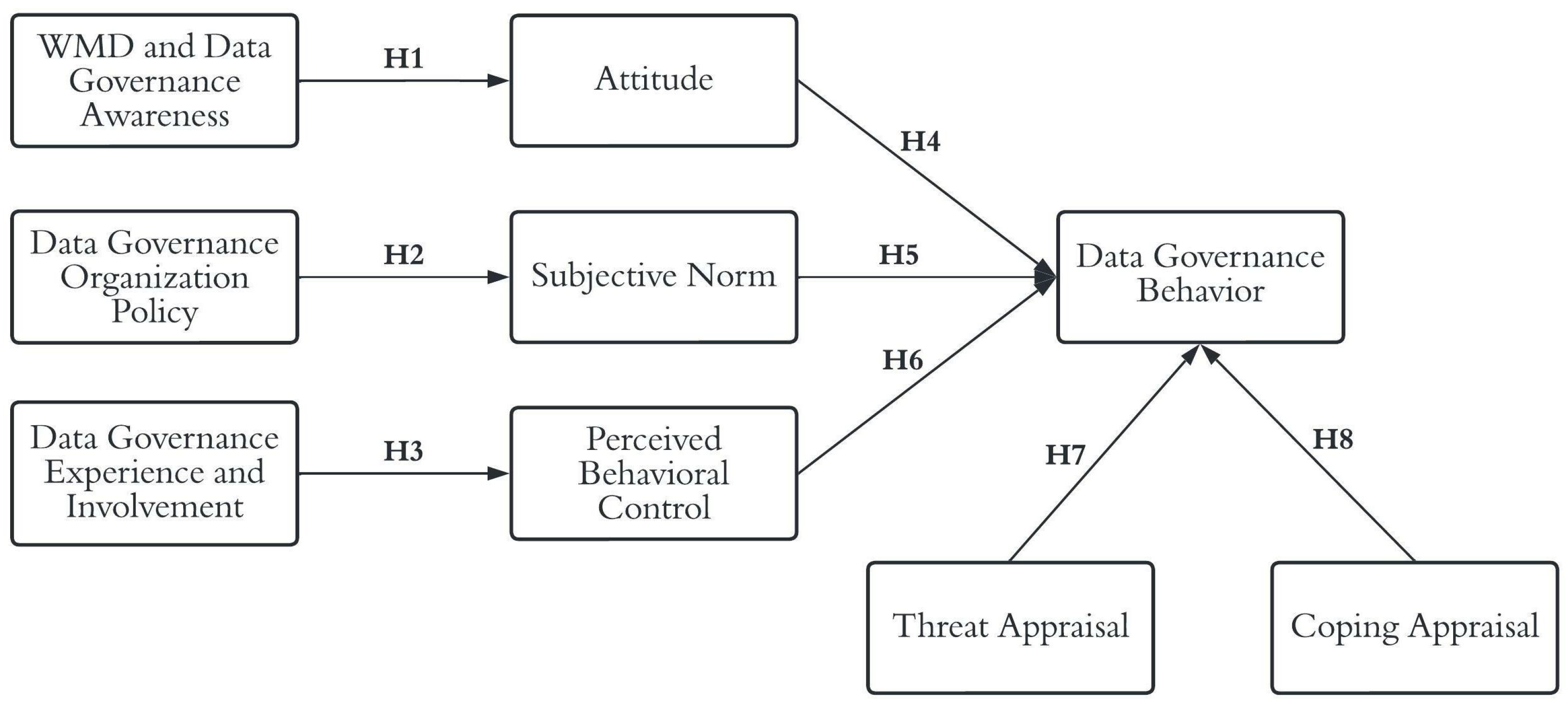
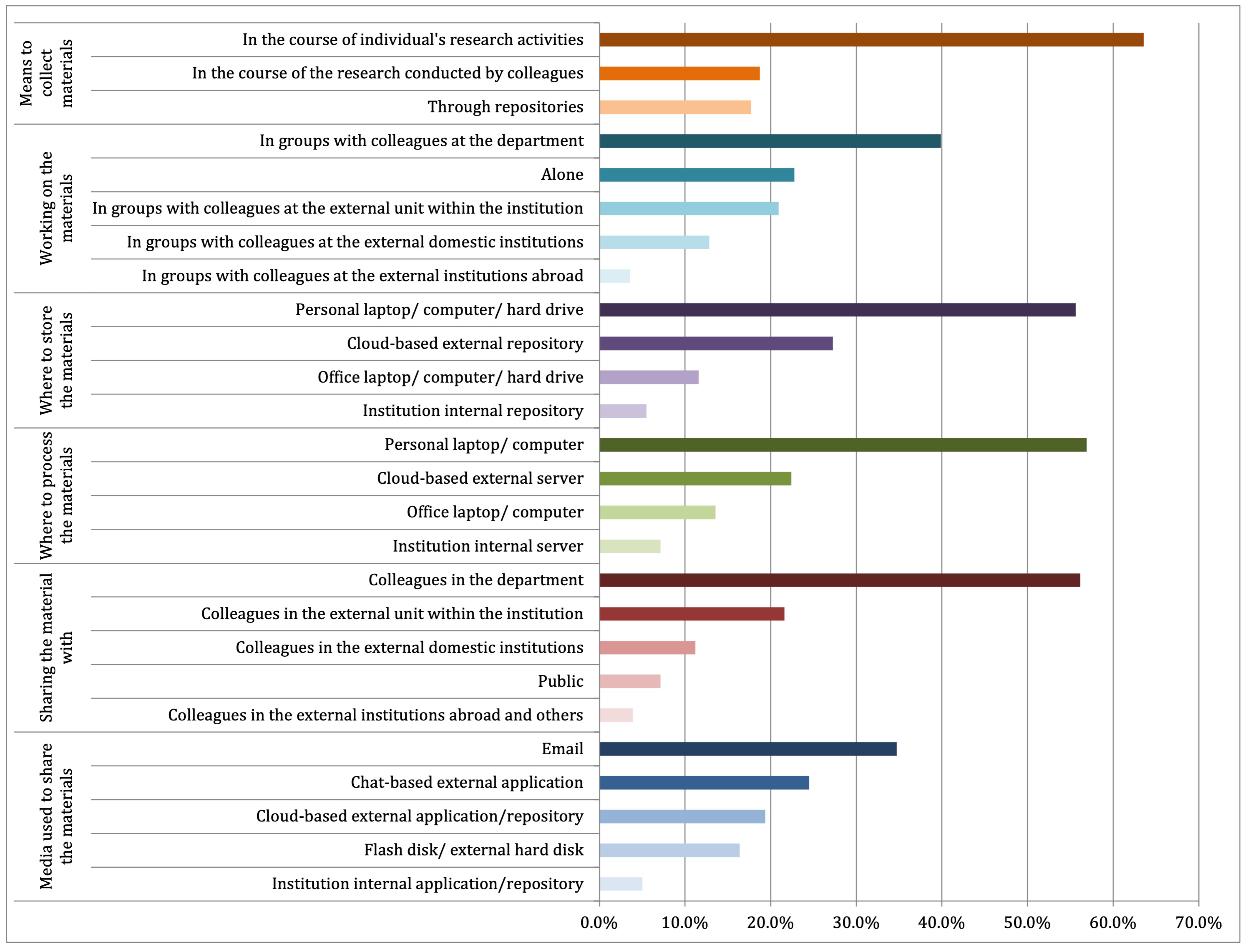
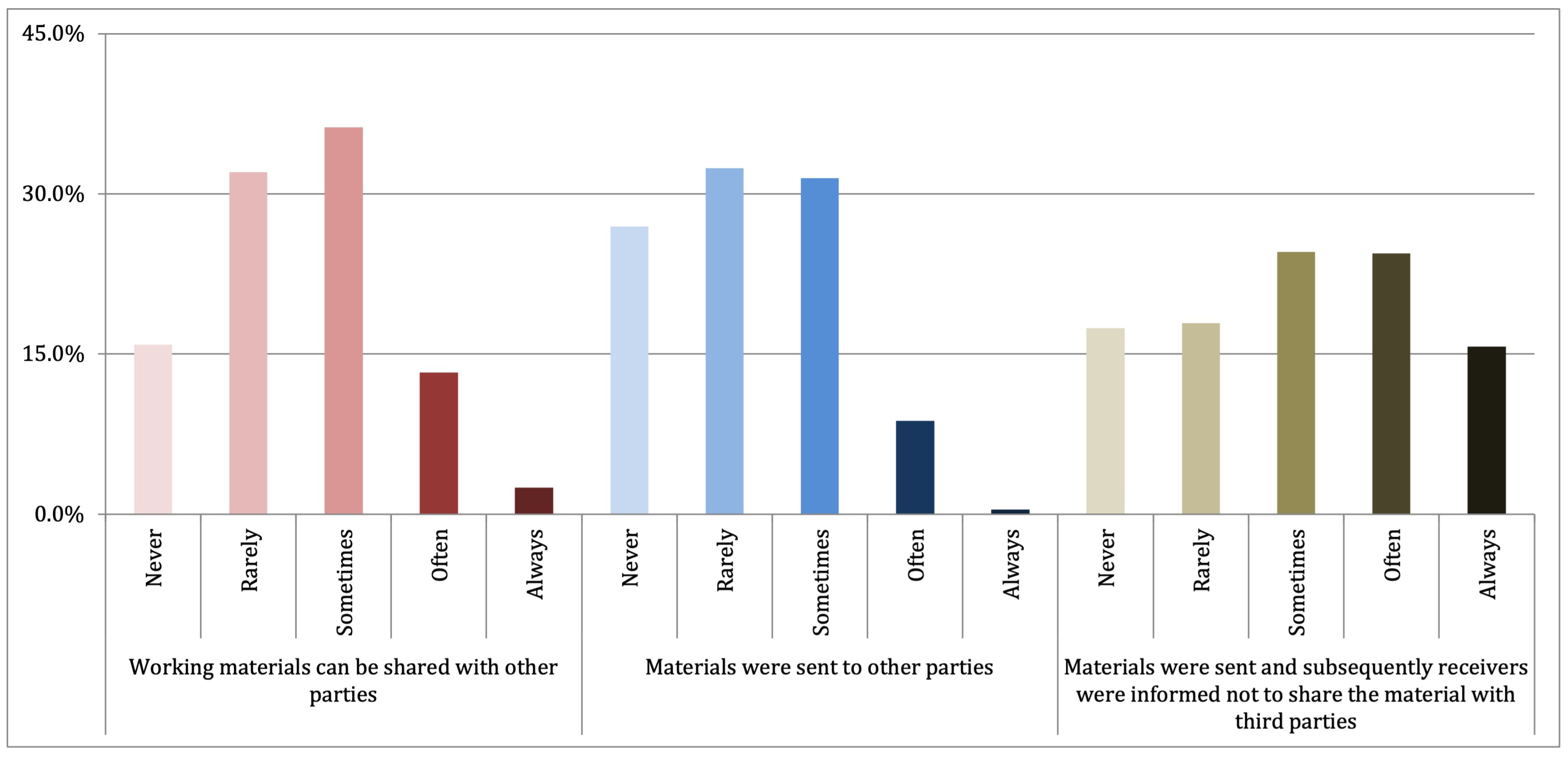
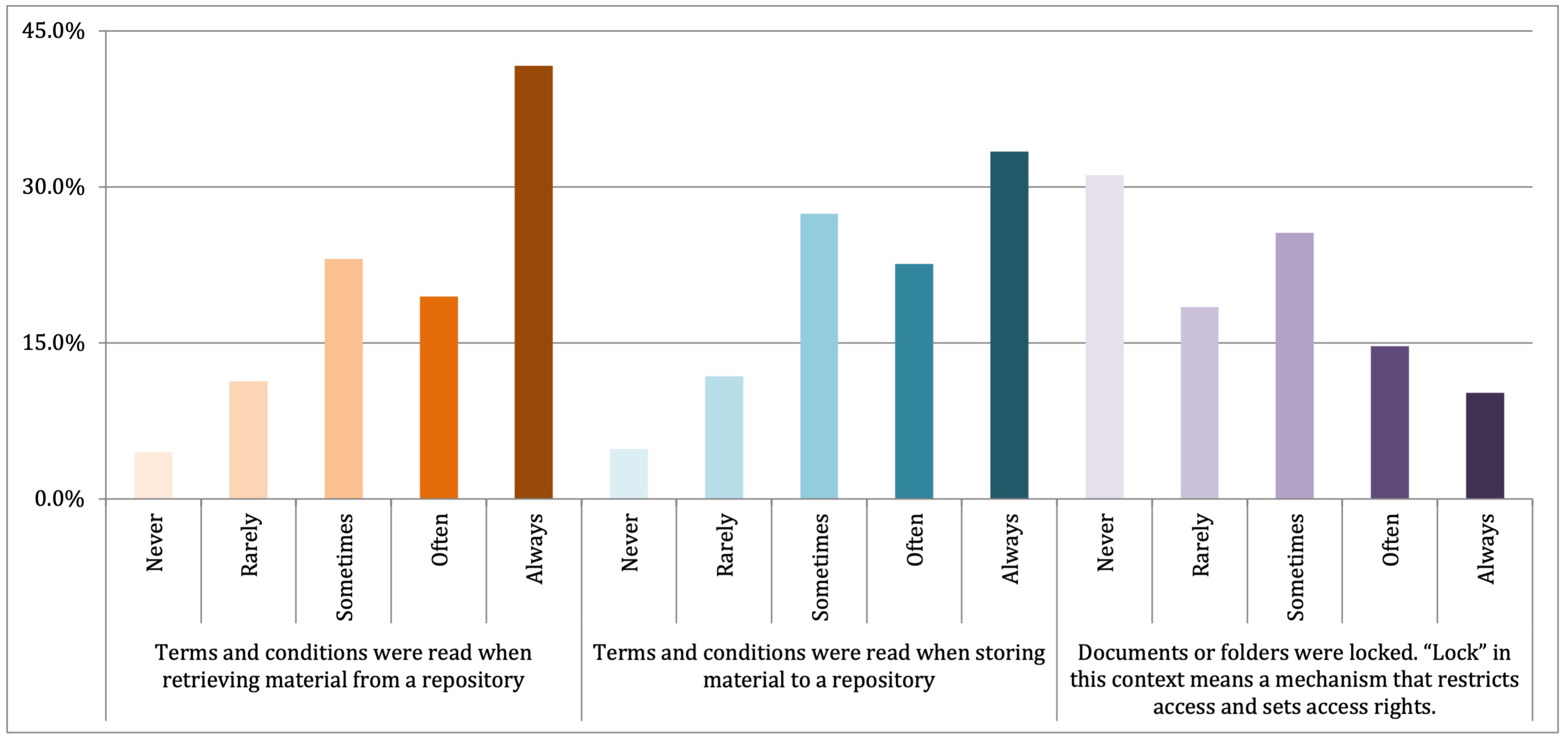
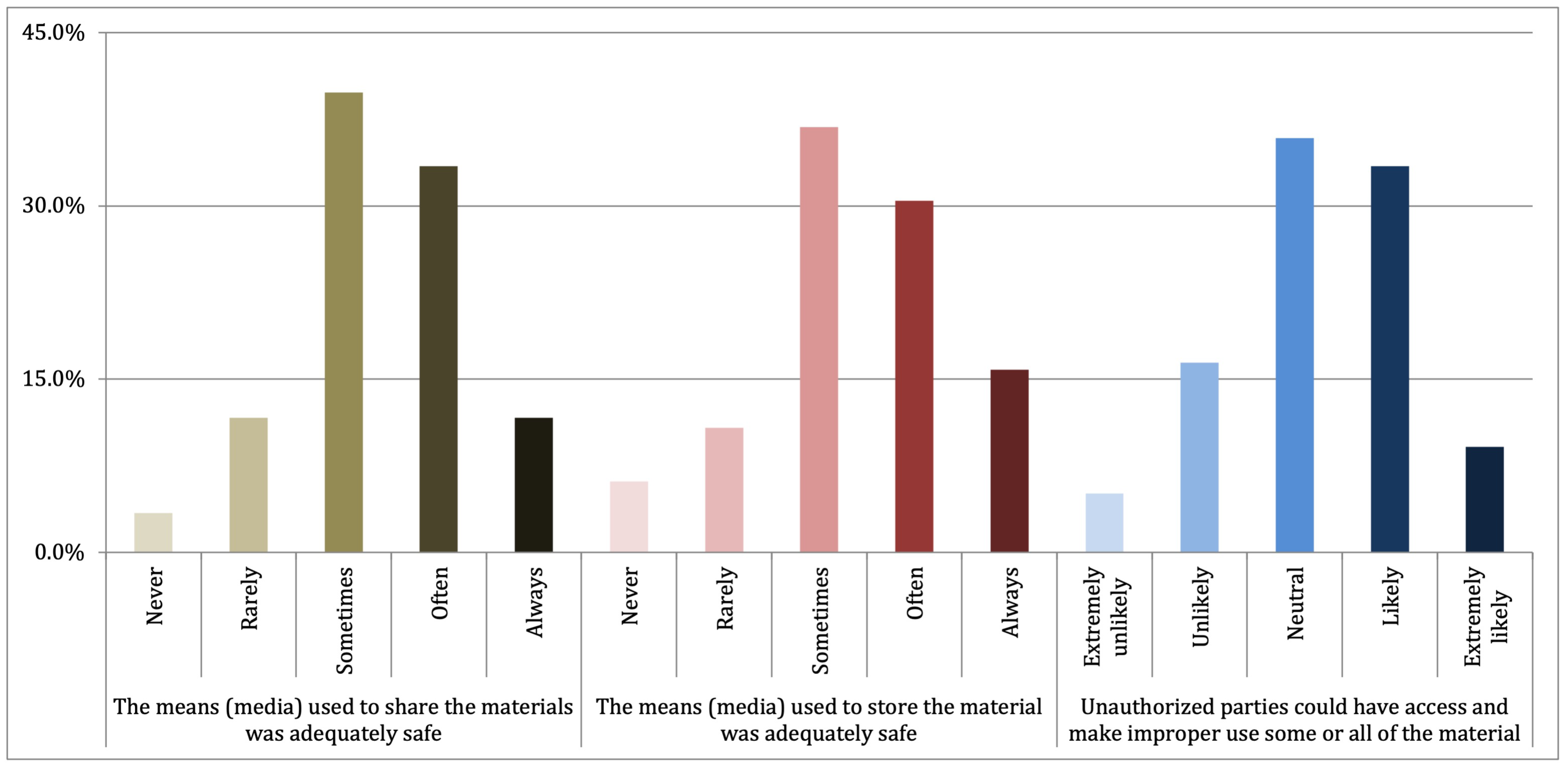

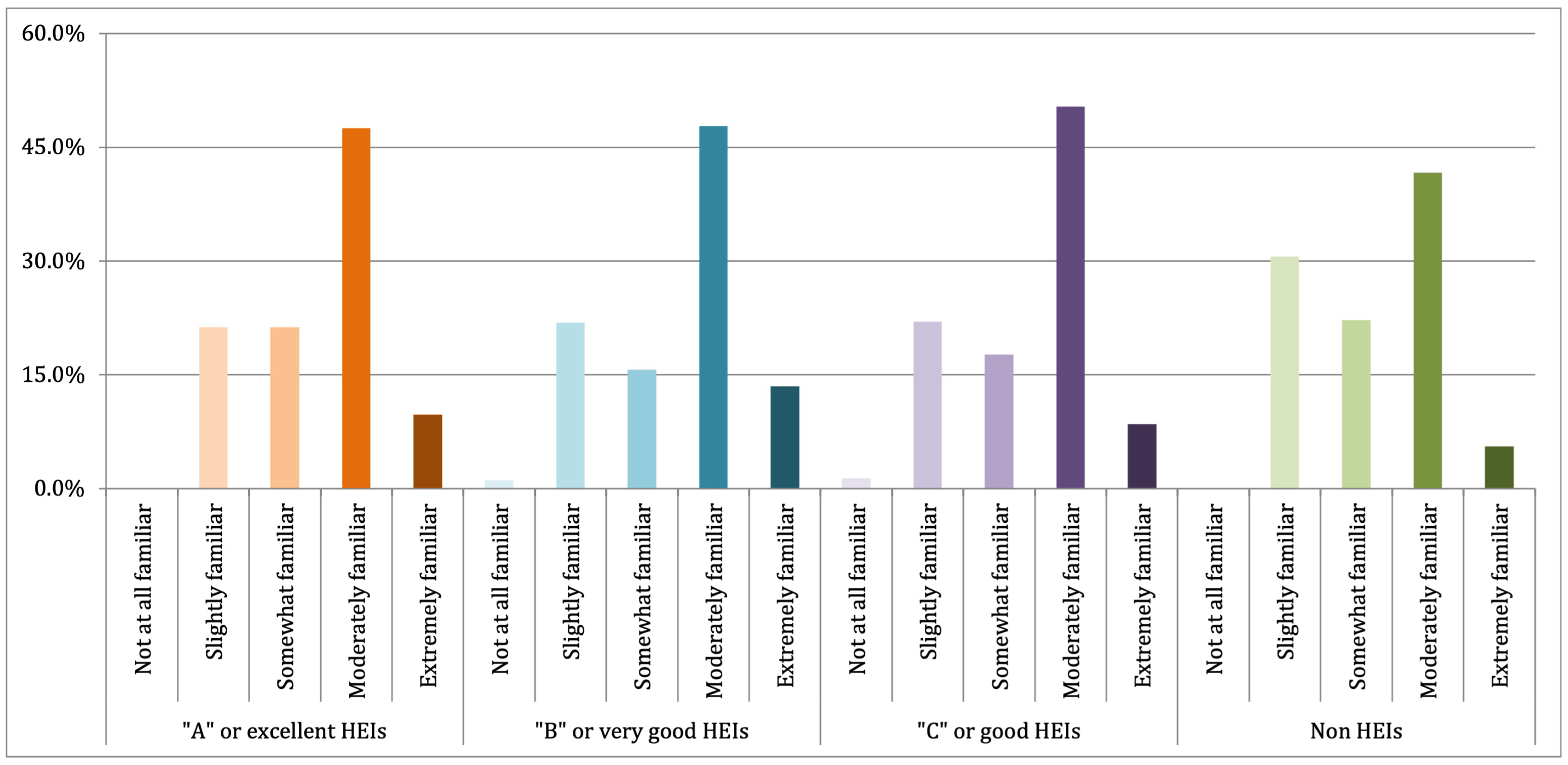


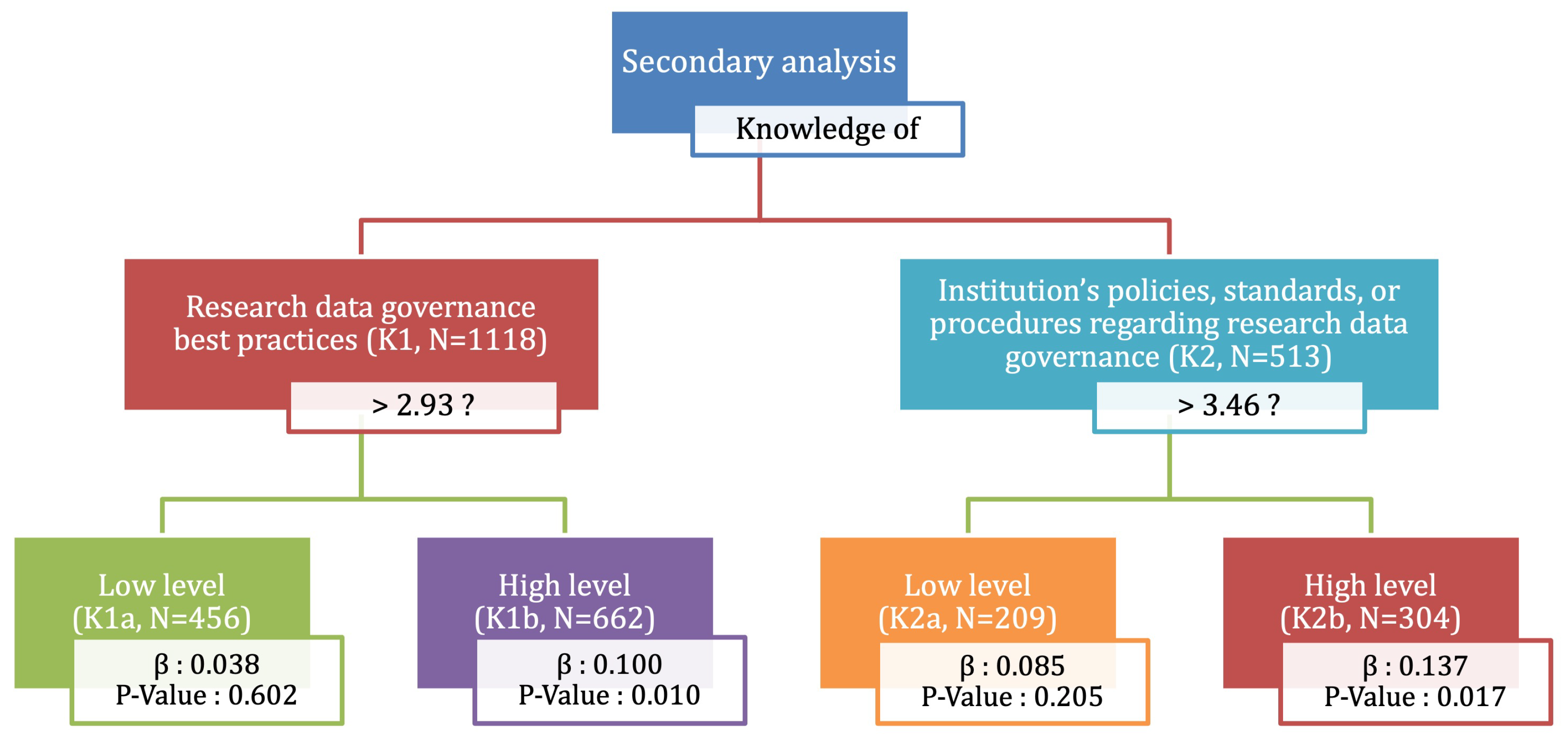

| Institution Types | Number of Scientists | Number of Affiliations | ||
|---|---|---|---|---|
| Population | Target | Population | Target | |
| “A" or “excellent” HEIs | 77,516 | 798 | 99 | 89 |
| “B” or “very good” HEIs | 100,609 | 2982 | 883 | 707 |
| “C” or “good” HEIs | 37,632 | 2032 | 1503 | 714 |
| Not accredited HEIs | 12,251 | 1639 | 858 | 378 |
| Government and corporate institutions | 5556 | 235 | 82 | 46 |
| Total | 233,564 | 7686 | 3425 | 1934 |
| Demographic | Main Affiliation | |||
|---|---|---|---|---|
| HEIs | Non-HEI | Total | ||
| Gender | Female | 41.4% | 45.9% | 41.7% |
| Male | 58.6% | 54.1% | 58.3% | |
| Age | 20–30 years old | 10.6% | 5.4% | 10.3% |
| 31–40 years old | 49.6% | 36.5% | 48.7% | |
| 41–50 years old | 25.2% | 29.7% | 25.5% | |
| 51–60 years old | 12.2% | 17.6% | 12.5% | |
| 61–70 years old | 2.4% | 10.8% | 3.0% | |
| Last Education | Bachelor’s degree | 0.4% | 9.5% | 1.0% |
| Master’s degree | 75.5% | 54.1% | 74.1% | |
| Doctorate’s degree | 24.1% | 36.5% | 25.0% | |
| Accreditation of the HEIs | A or excellent | 13.4% | 0.0% | 12.5% |
| B or very good | 53.7% | 0.0% | 50.2% | |
| C or good | 32.9% | 0.0% | 30.7% | |
| Non-HEI | 0.0% | 100.0% | 6.6% | |
| Research experience | 0–10 years | 64.1% | 35.1% | 62.2% |
| 10–20 years | 27.9% | 41.9% | 28.8% | |
| 20–30 years | 6.1% | 9.5% | 6.4% | |
| 30 years | 1.9% | 13.5% | 2.7% | |
| Scientific field | Health sciences | 26.0% | 20.3% | 25.6% |
| Life sciences | 18.6% | 29.7% | 19.3% | |
| Physical sciences | 43.8% | 40.5% | 43.6% | |
| Social sciences | 11.7% | 9.5% | 11.5% | |
| Variable | Indicator | Mean | Std Dev | CR | AVE | Factor Loading | Cronbach’s Alpha Coefficient |
|---|---|---|---|---|---|---|---|
| WMD and Data Governance Awareness | aw1 | 3.68 | 0.63 | 0.83 | 0.50 | 0.59 | 0.75 |
| aw2 | 0.67 | ||||||
| aw3 | 0.78 | ||||||
| aw4 | 0.80 | ||||||
| aw5 | 0.69 | ||||||
| Data Governance Organization Policy | op1 | 3.81 | 0.58 | 0.84 | 0.52 | 0.74 | 0.76 |
| op2 | 0.79 | ||||||
| op3 | 0.68 | ||||||
| op4 | 0.81 | ||||||
| op5 | 0.54 | ||||||
| Data Governance Experience and Involvement | ei1 | 3.74 | 0.61 | 0.90 | 0.60 | 0.78 | 0.87 |
| ei2 | 0.70 | ||||||
| ei3 | 0.83 | ||||||
| ei4 | 0.77 | ||||||
| ei5 | 0.82 | ||||||
| ei6 | 0.75 | ||||||
| Attitude | att1 | 4.20 | 0.55 | 0.91 | 0.67 | 0.84 | 0.87 |
| att2 | 0.88 | ||||||
| att3 | 0.88 | ||||||
| att4 | 0.71 | ||||||
| att5 | 0.77 | ||||||
| Subjective Norm | sn1 | 3.67 | 0.59 | 0.87 | 0.53 | 0.70 | 0.82 |
| sn2 | 0.84 | ||||||
| sn3 | 0.87 | ||||||
| sn4 | 0.78 | ||||||
| sn5 | 0.56 | ||||||
| sn6 | 0.59 | ||||||
| Perceived Behavioral Control | pbc1 | 3.98 | 0.53 | 0.86 | 0.61 | 0.73 | 0.79 |
| pbc2 | 0.81 | ||||||
| pbc3 | 0.78 | ||||||
| pbc4 | 0.79 | ||||||
| Threat Appraisal | ta1 | 4.26 | 0.53 | 0.90 | 0.59 | 0.74 | 0.86 |
| ta2 | 0.74 | ||||||
| ta3 | 0.83 | ||||||
| ta4 | 0.79 | ||||||
| ta5 | 0.82 | ||||||
| ta6 | 0.69 | ||||||
| Coping Appraisal | ca1 | 3.56 | 0.65 | 0.93 | 0.69 | 0.79 | 0.91 |
| ca2 | 0.82 | ||||||
| ca3 | 0.86 | ||||||
| ca4 | 0.86 | ||||||
| ca5 | 0.80 | ||||||
| ca6 | 0.85 | ||||||
| Data Governance Behavior | dgb1 | 3.92 | 0.52 | 0.89 | 0.57 | 0.74 | 0.85 |
| dgb2 | 0.77 | ||||||
| dgb3 | 0.81 | ||||||
| dgb4 | 0.80 | ||||||
| dgb5 | 0.71 | ||||||
| dgb6 | 0.70 |
| Criteria | Cut-Off Value | Results | References |
|---|---|---|---|
| <5 | 5 | [67,68,69] | |
| rms_theta | <0.12 | 0.10 | [70] |
| SRMR | ≤0.09 | 0.08 | [71] |
| Level of Knowledge (1–5) | Non-HEIs | HEIs | Total | |||
|---|---|---|---|---|---|---|
| Mean | Std Dev | Mean | Std Dev | Mean | Std Dev | |
| Research data governance best practices | 2.82 | 1.03 | 2.94 | 1.08 | 2.93 | 1.07 |
| Institution’s policies, standard, or procedures regarding research data governance | 3.22 | 0.96 | 3.48 | 0.99 | 3.46 | 0.99 |
Publisher’s Note: MDPI stays neutral with regard to jurisdictional claims in published maps and institutional affiliations. |
© 2022 by the authors. Licensee MDPI, Basel, Switzerland. This article is an open access article distributed under the terms and conditions of the Creative Commons Attribution (CC BY) license (https://creativecommons.org/licenses/by/4.0/).
Share and Cite
Manik, L.P.; Akbar, Z.; Yaman, A.; Indrawati, A. Indonesian Scientists’ Behavior Relative to Research Data Governance in Preventing WMD-Applicable Technology Transfer. Publications 2022, 10, 50. https://doi.org/10.3390/publications10040050
Manik LP, Akbar Z, Yaman A, Indrawati A. Indonesian Scientists’ Behavior Relative to Research Data Governance in Preventing WMD-Applicable Technology Transfer. Publications. 2022; 10(4):50. https://doi.org/10.3390/publications10040050
Chicago/Turabian StyleManik, Lindung Parningotan, Zaenal Akbar, Aris Yaman, and Ariani Indrawati. 2022. "Indonesian Scientists’ Behavior Relative to Research Data Governance in Preventing WMD-Applicable Technology Transfer" Publications 10, no. 4: 50. https://doi.org/10.3390/publications10040050
APA StyleManik, L. P., Akbar, Z., Yaman, A., & Indrawati, A. (2022). Indonesian Scientists’ Behavior Relative to Research Data Governance in Preventing WMD-Applicable Technology Transfer. Publications, 10(4), 50. https://doi.org/10.3390/publications10040050






